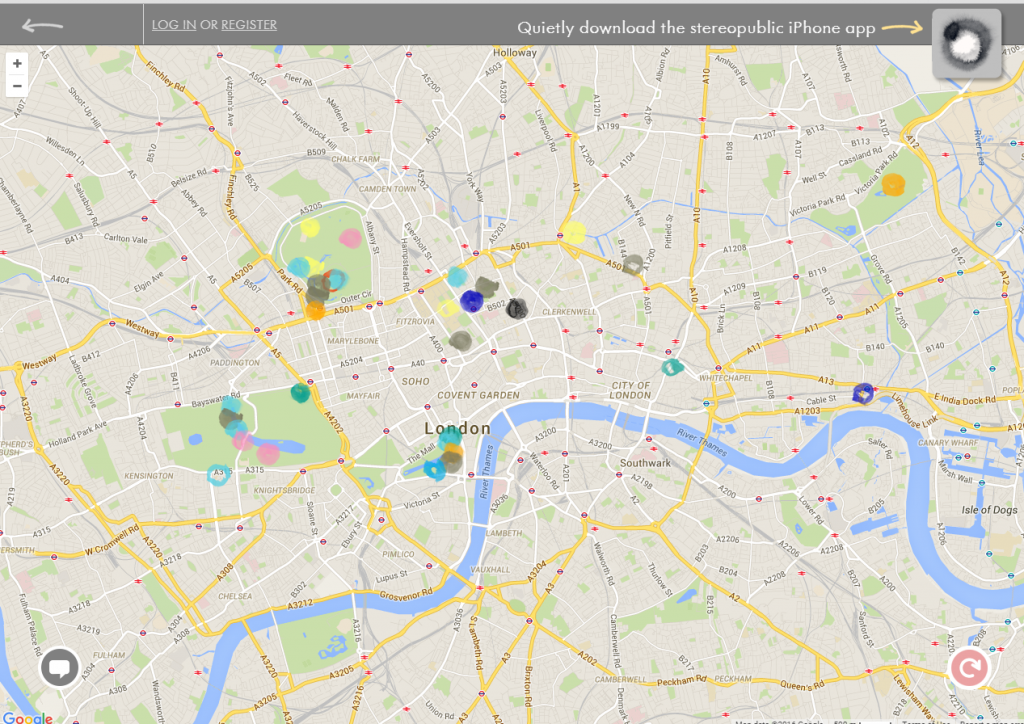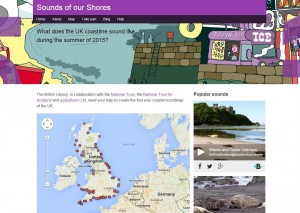You Are Hear is not the only project that is looking at the impact of sound on perceptions of place. Our project team is keeping an eye on similar projects and putting them together for your enjoyment here.
What does a building sound like? For an audio exhibition opening in September 2017, artists have been commissioned to compose a piece of music inspired by a building in the Borough of Southwark. How can a building’s architecture, its inhabitants, its atmosphere be interpreted in music? And how does listening to that music enhance a sense of place? The recordings are only available to hear while you are on location, so take your mobile device of choice to Southwark and try it out.
—–
Update: Save our Sounds project awarded further funding
The British Library has announced that their ambitious Save our Sounds project has received funding to proceed with one strand, Unlocking our Sound Heritage. This will see the creation of ten regional sound preservation centres across the country, each equipped to start tackling the thousands of sound recordings in urgent need of preservation. Read the full press release for more information.
—–
An enormous collection of sounds recorded around London from the 1930s to the present. You can explore recordings by place, category, or project. Caution: once you start exploring, you won’t want to stop! We are grateful to the site’s developer, Ian Rawes, for advice given when we were developing our Essex Sounds map.
—–
The Europeana Sounds project has now made thousands of music recordings collected from across Europe freely available to play through their online radio site. Now they need your help to improve the information about the recordings. Can you tag a track with its genre?
—–
Similar to the Sounds of our Shores project, the new ‘Taste of Sound‘ project is seeking to collect the soundscapes of food from across the world. Can you help upload your local alimentary recordings? Whether it’s concerned with preparing, selling, or eating food, any recording will help show the global diversity of eating habits.
—–
Sacred Spaces
The Cities and Memory project is now directing our audio attention to Sacred Spaces. The team is calling for public contributions of recordings made in religious buildings. Can you help? They want all recordings submitted by 5 December 2016, so they can then seek artists to re-imagine the collection of sounds. Is our recording made inside St Peter’s Chapel, Bradwell-on-Sea, too quiet for this?
—–
The Next Station
Our Sound Recordist, Stuart Bowditch, has contributed to another sound map recently: a map of the sounds of the London Underground. The Next Station is part of the Cities and Memory project, and brings together sounds recorded at different stations with artistic interpretations of them. Which is your favourite station?
—–
Jaywick for Happiness
Do you have fond memories of seaside holidays in Jaywick? Last year’s Jaywick for Happiness project brought together pictures, film, and oral history recordings to capture what Jaywick Sands was like in its heyday as a tourist destination. You can follow a trail around the town, or access the material on their website.
—–
A Quiet Map
Do you seek out quiet places, havens of calm in the midst of bustling cities? stereopublic is a crowd-sourcing project that encourages people to find and share quiet places in busy environments. You can explore peaceful spots that others have discovered; listen to compositions inspired by those places; and suggest your own – if you’re willing to give them away! How do the soundscapes of these quiet places compare with more typical urban soundscapes?
—–
Update: Directory of UK Sound Collections Published
After an extensive survey, the British Library have now published their Directory of UK Sound Collections. It is free for anyone to download. Knowing the extent of the sound recordings out there is the first step towards creating a strategy for helping to digitise and preserve them. We look forward to further updates on the Save our Sounds project.
—–
Sounds of Summer!
Are you heading to the beach this summer? Why not make a recording while you are there? The British Library, the National Trust, and the National Trust for Scotland are collaborating with audioBoom Ltd to create a soundmap of Britain’s shoreline at this moment in time, the summer of 2015. They are asking members of the public to upload recordings made in coastal areas, to be shared on their Sounds of our Shores audioBoom channel. To find out more, visit the British Library’s project page. And get recording: you only have until 21 September!
—–
Europeana Creative is nearing the end of over two years of work on promoting the re-use of cultural heritage resources across Europe. It encourages creative use of material posted on Europeana, an online portal bringing together digital heritage material from 14 different European countries. One of the project outputs is Sound Connections. Using the Historypin interface, the project has grouped sound recordings into four categories that can be explored through a map: Birdlife in the UK and Netherlands, Aviation in the Netherlands, Citylife in Amsterdam, and Citylife in London. As well as posting them for people to enjoy, offering the chance to immerse yourself in a foreign city or sharpen your bird/plane-spotting skills, they are calling on people to contribute by adding information about the recordings. Do you recognise a sound on the map?
—–
Keeping up with the receipt of new material at the Essex Sound and Video Archive is a challenging task when so many worthwhile projects are conducting oral history interviews, capturing the memories of the people of Essex living at different times and in different circumstances.
The Foundation for Indian Performing Arts, based in Loughton, has recently been granted £35,000 from the Heritage Lottery Fund for their oral history project, ‘Beyond the Gurkhas’. The interviews will demonstrate the contributions made by Nepalese people in Britain, beyond serving in the British army as Gurkhas. Look out for updates on their news page.
—–
You Are Hear is not the only project concerned with digitising fragile audio and video recordings.

The London’s Screen Archives project is bringing together partners from local archive services, specialist institutions, private owners, and businesses based in London, to pool resources and ensure the city’s films are identified, saved through digitisation, and shared. They are even making some of them freely available online for all to enjoy.
Meanwhile, the British Library Sound Archive is embarking on a project to save the recorded sounds of the whole nation. Save our Sounds will begin with a national audit to give a clearer picture of the extent and condition of sound archives across the country. The British Library will then be able to offer advice and discuss potential ways forward with partner institutions.
Excerpts from a selection of the British Library’s extensive collections of unique sound recordings, which cover the entire range of recorded sound: music, drama and literature, oral history, wildlife and environmental sounds. – See more here.
Have a look to see how you can support these worthwhile causes.
—–
The Berlin Wall of Sound is an acoustic reconstruction of the Berlin Wall, created to commemorate the twenty-fifth anniversary of the fall of the Wall in 1989. Tags depict the victims and mark where they were killed. Warning: the content is upsetting and, in sound form, is all the more vividly brought to life – and death.
—–



